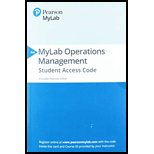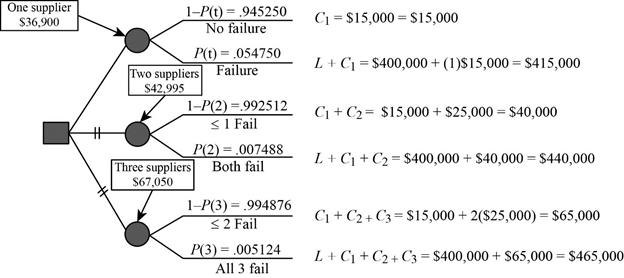
Concept explainers
To determine: The number of suppliers to be chosen by Company W.
Introduction:
Answer to Problem 3P
TheCompany W can choose one supplier.
Explanation of Solution
Given information:
Formula:
Calculation for supplier selection:
Probability of selecting one supplier:

To find the probability of selecting one supplier, substitute the number of chosen suppliers, probability of super-event and unique-event in the above formula. Here, the number of suppliers chosen is ‘1’; S=0.005 and U=0.05 are substituted in the above formula, which gives the probability as 0.05475.
Probability of selecting two suppliers:

To find the probability of selecting two suppliers, substitute the number of chosen suppliers, probability of super-event and unique-event in the above formula. Here, the number of suppliers chosen is ‘2’; S=0.005 and U=0.05 are substituted in the above formula, which gives the probability as 0.007488.
Probability of selecting three suppliers:

To find the probability of selecting three suppliers, substitute the number of chosen suppliers, probability of super-event and unique-event in the above formula. Here, the number of suppliers chosen is ‘3’; S=0.005 and U=0.05 are substituted in the above formula, which gives the probability as 0.00512.

Calculation of cost:
Failure cost and no-failure cost is calculated for every number of suppliers selected.
- When one supplier is selected:
- Calculation of no-failure cost:
When there is no failure of supplier, then there is no loss, when one supplier is selected. The only cost associated with the supplier selection is the marginal cost.
Probability of no-failure for one supplier,
- Calculation of failure cost:
When the supplier selection fails, along with marginal cost, the supplier failure cost is also added to the failure cost.
- Calculation of total cost:
The total cost is calculated by summing up the values obtained by multiplying the cost with respective probabilities.
The total cost of selecting one supplier is $36,900.
- When two suppliers are selected:
- Calculation of no-failure cost:
When there is no failure of suppliers, then there is no loss, when two suppliers are selected. The only cost associated with the supplier selection is the marginal cost.
Probability of no-failure for two suppliers,
- Calculation of failure cost:
When the supplier selection fails, along with marginal cost, the supplier failure cost is also added to the failure cost.
- Calculation of total cost:
The total cost is calculated by summing up the values obtained by multiplying the cost with respective probabilities.
The total cost of selecting two suppliers is $42,995.
- When three suppliers are selected:
- Calculation of no-failure cost:
When there is no failure of suppliers, then there is no loss, when three suppliers are selected. The only cost associated with the supplier selection is the marginal cost.
Probability of no-failure for three suppliers,
- Calculation of failure cost:
When the supplier selection fails, along with marginal cost, the supplier failure cost is also added to the failure cost.
- Calculation of total cost:
The total cost is calculated by summing up the values obtained by multiplying the cost with respective probabilities.
The total cost of selecting three suppliers is $67,050.
From Equations ((1), (2) and (3)), it can be inferred that the total cost is low, when one supplier is selected. Therefore, it is advisable for Company W to select one supplier.
Hence, Company W can choose one supplier.
Want to see more full solutions like this?
Chapter 11 Solutions
Pearson eText Principles of Operations Management: Sustainability and Supply Chain Management -- Instant Access (Pearson+)
- Note: A waiting line model solver computer package is needed to answer these questions. The Kolkmeyer Manufacturing Company uses a group of six identical machines, each of which operates an average of 23 hours between breakdowns. With randomly occurring breakdowns, the Poisson probability distribution is used to describe the machine breakdown arrival process. One person from the maintenance department provides the single-server repair service for the six machines. Management is now considering adding two machines to its manufacturing operation. This addition will bring the number of machines to eight. The president of Kolkmeyer asked for a study of the need to add a second employee to the repair operation. The service rate for each individual assigned to the repair operation is 0.40 machines per hour. (a) Compute the operating characteristics if the company retains the single-employee repair operation. (Round your answers to four decimal places. Report time in hours.) La = L = Wa W = h…arrow_forwardBurger Dome sells hamburgers, cheeseburgers, french fries, soft drinks, and milk shakes, as well as a limited number of specialty items and dessert selections. Although Burger Dome would like to serve each customer immediately, at times more customers arrive than can be handled by the Burger Dome food service staff. Thus, customers wait in line to place and receive their orders. Burger Dome analyzed data on customer arrivals and concluded that the arrival rate is 40 customers per hour. Burger Dome also studied the order-filling process and found that a single employee can process an average of 56 customer orders per hour. Burger Dome is concerned that the methods currently used to serve customers are resulting in excessive waiting times and a possible loss of sales. Management wants to conduct a waiting line study to help determine the best approach to reduce waiting times and improve service. Suppose Burger Dome establishes two servers but arranges the restaurant layout so that an…arrow_forwardAgan Interior Design provides home and office decorating assistance to its customers. In normal operation, an average of 2.6 customers arrive each hour. One design consultant is available to answer customer questions and make product recommendations. The consultant averages 10 minutes with each customer. (a) Compute the operating characteristics of the customer waiting line, assuming Poisson arrivals and exponential service times. (Round your answers to four decimal places. Report time in hours.) λ= μ = = L = Wa W = P. W h (b) Service goals dictate that an arriving customer should not wait for service more than an average of 5 minutes. Is this goal being met? (Round your answer to one decimal place.) W₁ (in minutes) = min, which is ---Select--- than the desired wait time, so the goal ---Select--- met. What action do you recommend? (Select all that apply.) Hire another consultant. Increase the hours of operation. Decrease the mean service rate. Increase the mean service rate. There is…arrow_forward
- Communication Tips (2015) Tactful bragging Respond to the question "So, what do you do?" Whether you are student or have a job/internship, how can you tactfully brag in your answer to this question? Use the three elements from the video (listed below) when crafting your brag statement: Focus on results vs title Process vs job description Loop back to listener Example of an instructor's brag statement: "I help hundreds of students each semester to connect with one another, develop communication skills and prepare for upcoming interviews. Through improv games we explore presence, flexibility, and storytelling. How have your networking experiences on campus been so far?"arrow_forwardAccounting problemarrow_forwardGovernment's new plan to shift cargo from roads back to rail 26TH JANUARY 2024 Government is seeking to finalise a plan aimed at improving its rail network and move cargo away from a billion rand per day to its logistics crises, government has said an urgentturnaround is needed to improve its 31 000km locomotive network as more and more cargo moves from rail to trucks. The Department of Transport (DoT) hosted a discussion with industry stakeholders regarding the Freight Road to Rail Migration Plan on Thursday - the latest development in the wake of President Cyril Ramphosa forming the National Logistics Crisis Committee last year. Transnet, the South African National Roads Agency (Sanral) and private sector companies were all in attendance. The Freight Road to Rail Migration Plan is part of government's strategies to improve the country's ongoing logistics crises. In October last year, the government unveiled its Freight Logistics Roadmap to improve the ports and rail networks and…arrow_forward
- Assess what led to such logistical inefficiencies / collapse of a previously world class freight networkarrow_forwardWhich of the following statements concerning the evaluation of training programs is true? Most companies thoroughly evaluate the return on investment of their training programs It is relatively easy to establish a control group and a treatment group for evaluation Results level of evaluation measures how well participants liked the program Behavior level criteria measure whether skills learned in training result in behavior changes back on the jobarrow_forwardEligibility testing is an disparate impact validation method none of the above a method to validate promotions and progressive discipline activity a test an employee administers to ensure that the potential employee is capable and qualified to perform the requirements of the positionarrow_forward
- A no-strike pledge by a union in a collective bargaining agreement is given in return for management’s agreement to: a grievance procedure a union shop a wage increase a fringe benefit increase binding arbitration of grievancesarrow_forwardWhich is the major OD technique that is used for increasing the communication, cooperation, and cohesiveness of work units? Leadership analysis Developing objectives Groupthink Strategic Planning team Buildingarrow_forwardAn American multinational firm usually is less than fully successful in adapting itself to local practices in each country because: American managers are often ignorant of local conditions None of the above management direction may be centralized in the home office All of the above Foreign subsidiaries often have American managersarrow_forward
 Purchasing and Supply Chain ManagementOperations ManagementISBN:9781285869681Author:Robert M. Monczka, Robert B. Handfield, Larry C. Giunipero, James L. PattersonPublisher:Cengage Learning
Purchasing and Supply Chain ManagementOperations ManagementISBN:9781285869681Author:Robert M. Monczka, Robert B. Handfield, Larry C. Giunipero, James L. PattersonPublisher:Cengage Learning Practical Management ScienceOperations ManagementISBN:9781337406659Author:WINSTON, Wayne L.Publisher:Cengage,
Practical Management ScienceOperations ManagementISBN:9781337406659Author:WINSTON, Wayne L.Publisher:Cengage, Contemporary MarketingMarketingISBN:9780357033777Author:Louis E. Boone, David L. KurtzPublisher:Cengage Learning
Contemporary MarketingMarketingISBN:9780357033777Author:Louis E. Boone, David L. KurtzPublisher:Cengage Learning





